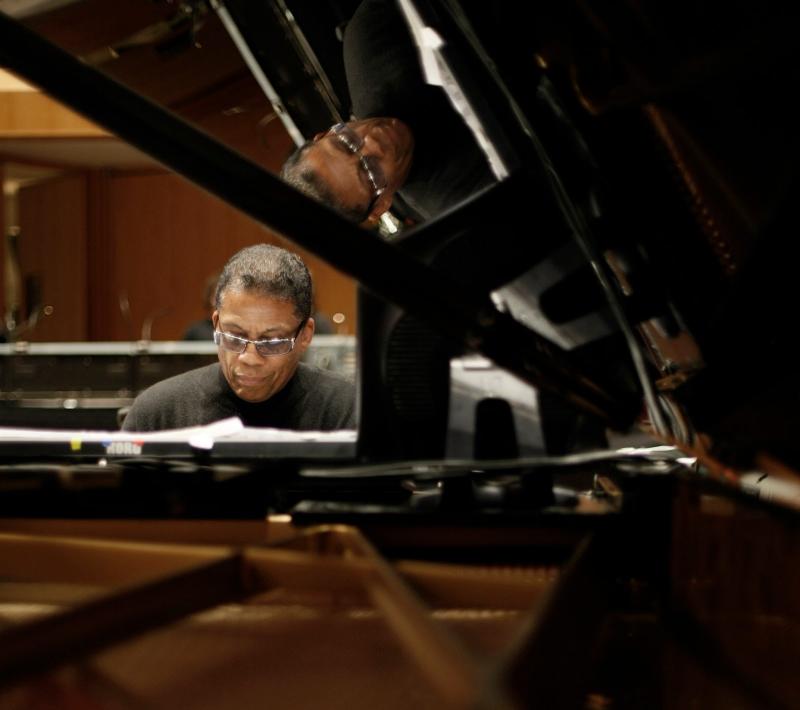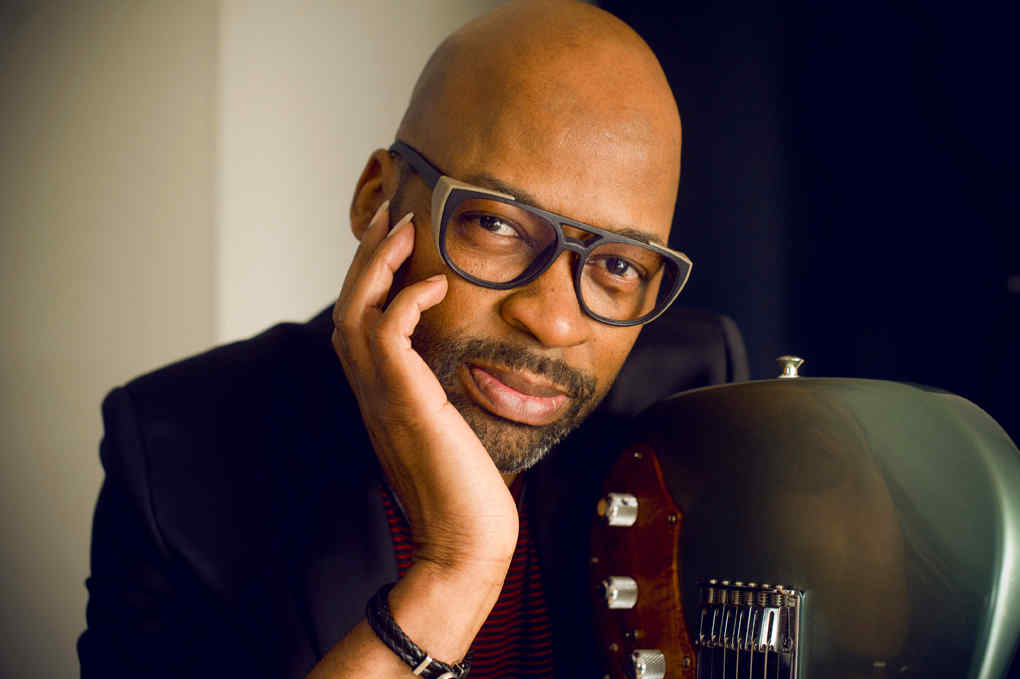Herbie Hancock, Barbican EFG London Jazz Festival review – the musical chameleon is still searching at 79 | reviews, news & interviews
Herbie Hancock, Barbican EFG London Jazz Festival review – the musical chameleon is still searching at 79
Herbie Hancock, Barbican EFG London Jazz Festival review – the musical chameleon is still searching at 79
Despite some longueurs, the multi-skilled bandleader remains an irresistibly joyful force

When it comes to the true jazz legends capable of filling concert halls with faithful fans, whom jazz festival programmers can put on as headliners, the choice is dwindling.
Hancock’s entrance onto the Barbican stage was greeted with a loud roar. Two hours later, the final sequence of the tunes which one would expect had the complete packed house up on its feet, with the keytar-toting hero strutting his way through “Cantaloupe Island” followed by the extended encore “Chameleon”. Everything seemed right with the world as the 79-year old then shook any number of fans’ hands, thanked the adoring public and moved on to more of the same at the after-party.
And yet here have been some discordant responses to earlier concerts of the current month-long tour, mostly of European concert halls by Hancock’s quintet. In Vienna there were reports of a “fan” vociferously demanding that the group play more jazz. And in Munich, the local broadsheet Süddeutsche Zeitung’s critic panned the show, describing it as “unpalatable,” and as an “unstructured sequence of effects and circus numbers.”
To Hancock’s credit, he has no intention of getting stuck in a rut. Yes, there was a party to be had at this concert, but you had to wait for it. The delivery of the audience’s expectations happened alongside a continuing search for the new. And in the lengthy appreciations that Hancock gave of each of his four band members, he gave the strongest clue as to where he wants and expects such inspiration and ideas to come from. In essence, he is happy to allow free creative rein to his younger cohorts, and to let their performances be the focus. Rather than wanting to lead from the front himself, he is happy to revert to being sideman taking the occasional solo. The show becomes as much about them as it is about him.
Maybe that’s a problem. It is his show. And whereas they are musicians who are clearly of interest musically to Hancock, they are chosen for that rather than for any obvious charisma as performers. And maybe in the context of "his" show there is an understandable reticence on their part to draw in attention on themselves rather than their boss. Whatever the reasons, to me there were definitely some longueurs in this show.
 The most varied and potent force Hancock has alongside him in the band is Benin-born guitarist Lionel Loueké (pictured left by Jean-Baptiste Millot), whom Hancock described last night as having the creativity of “nine different people in one body.” The story of their very first meeting is testament to the fact that Hancock’s fascination and admiration for Loueké started strong and has remained undiminished. It bears re-telling: Loueké had presented himself as an audition candidate for what was then the Monk Institute, and Herbie’s appraisal was: “How about I just take Lionel on the road and we forget about the Monk Institute?” Loueké’s range of guitar and vocal sounds is astonishing. He was given extended features both as instrumentalist and vocalist and does indeed take the band off in unexpected directions. And when he makes his guitar sound like Hancock’s keyboard synth, it can be – presumably deliberately – disorientating.
The most varied and potent force Hancock has alongside him in the band is Benin-born guitarist Lionel Loueké (pictured left by Jean-Baptiste Millot), whom Hancock described last night as having the creativity of “nine different people in one body.” The story of their very first meeting is testament to the fact that Hancock’s fascination and admiration for Loueké started strong and has remained undiminished. It bears re-telling: Loueké had presented himself as an audition candidate for what was then the Monk Institute, and Herbie’s appraisal was: “How about I just take Lionel on the road and we forget about the Monk Institute?” Loueké’s range of guitar and vocal sounds is astonishing. He was given extended features both as instrumentalist and vocalist and does indeed take the band off in unexpected directions. And when he makes his guitar sound like Hancock’s keyboard synth, it can be – presumably deliberately – disorientating.
Bassist James Genus is one of those gold-standard players. Every touch of the instrument counts and means something. He almost shrugs indifferently as he delivers jaw-dropping virtuosity high up the fingerboard. One problem he had last night, however, was that he was not always caught very clearly in the sound mix, at least from where I sat.
As rhythmic company Genus has drummer Justin Tyson, whom Hancock described as having been either “borrowed” or “stolen” from Robert Glasper. Tyson can sometimes play with finesse and has a high level of jazz responsiveness, but his core volume and intensity level are quite high. There is the rock legacy of, say, John Bonham or Simon Phillips in his sound as much as any jazz antecedents. His backbeat is insistent, not to say uncompromising. And anyone expecting him to underpin a track like “Cantaloupe Island” with the delicacy which Tony Williams does on the 1964 original would be sorely disappointed.
Flautist/ singer Elena Pinderhughes is a name to watch. She is still in her mid-twenties and is a wonderfully fluent improviser, but in a band where every other instrument can deploy a huge range of intensity and volume from low to high, the flute’s limitations are apparent.
Herbie Hancock refuses to succumb to the temptation of becoming his own tribute act or of turning the show into a mere celebration of "being Herbie". But when he does, finally, take the lead, he is an irresistibly joyful force.
The future of Arts Journalism
You can stop theartsdesk.com closing!
We urgently need financing to survive. Our fundraising drive has thus far raised £49,000 but we need to reach £100,000 or we will be forced to close. Please contribute here: https://gofund.me/c3f6033d
And if you can forward this information to anyone who might assist, we’d be grateful.

Subscribe to theartsdesk.com
Thank you for continuing to read our work on theartsdesk.com. For unlimited access to every article in its entirety, including our archive of more than 15,000 pieces, we're asking for £5 per month or £40 per year. We feel it's a very good deal, and hope you do too.
To take a subscription now simply click here.
And if you're looking for that extra gift for a friend or family member, why not treat them to a theartsdesk.com gift subscription?
more New music
 Album: Brìghde Chaimbeul - Sunwise
A singular sonic auteur reshapes traditional Celtic music
Album: Brìghde Chaimbeul - Sunwise
A singular sonic auteur reshapes traditional Celtic music
 Music Reissues Weekly: Rupert’s People - Dream In My Mind
How ‘A Whiter Shade of Pale’ transformed a London mod-pop band
Music Reissues Weekly: Rupert’s People - Dream In My Mind
How ‘A Whiter Shade of Pale’ transformed a London mod-pop band
 Album: JF Robitaille & Lail Arad - Wild Moves
A set of graceful, wry melancholy from an Anglo-Canadian singer-songwriter duo
Album: JF Robitaille & Lail Arad - Wild Moves
A set of graceful, wry melancholy from an Anglo-Canadian singer-songwriter duo
 Album: Lorde - Virgin
Sombre self-examination and scratchy cellos fail to ignite on the New Zealander's new LP
Album: Lorde - Virgin
Sombre self-examination and scratchy cellos fail to ignite on the New Zealander's new LP
 Album: Bruce Springsteen - Tracks II: The Lost Albums
The Boss: Finding joy in imperfections
Album: Bruce Springsteen - Tracks II: The Lost Albums
The Boss: Finding joy in imperfections
 Brad Mehldau Trio, St George's Bristol review - exquisite intelligence
A brilliant trio in scintillating conversation
Brad Mehldau Trio, St George's Bristol review - exquisite intelligence
A brilliant trio in scintillating conversation
 Ian Leslie: John and Paul - A Love Story in Songs review - help!
Ian Leslie loses himself in amateur psychology, and fatally misreads The Beatles
Ian Leslie: John and Paul - A Love Story in Songs review - help!
Ian Leslie loses himself in amateur psychology, and fatally misreads The Beatles
 Album: BC Camplight - A Sober Conversation
Brian Christinzio exorcises childhood trauma
Album: BC Camplight - A Sober Conversation
Brian Christinzio exorcises childhood trauma
 theartsdesk on Vinyl 91: Sex Pistols, Pink Floyd, Tropical Fuck Storm, Sparks, The Sisters of Mercy and more
The vastest regular record reviews in the galaxy
theartsdesk on Vinyl 91: Sex Pistols, Pink Floyd, Tropical Fuck Storm, Sparks, The Sisters of Mercy and more
The vastest regular record reviews in the galaxy
 Album: Durand and the Indications - Flowers
Languorous neo-soul to chill by
Album: Durand and the Indications - Flowers
Languorous neo-soul to chill by
 Music Reissues Weekly: The Sonics - High Time
Handsome box set of seven-inchers celebrating the ferocious Sixties rockers
Music Reissues Weekly: The Sonics - High Time
Handsome box set of seven-inchers celebrating the ferocious Sixties rockers
 Album: Benson Boone - American Heart
Retro-Americana, pop-rock sheen, and big-hearted ballads - all with a wink
Album: Benson Boone - American Heart
Retro-Americana, pop-rock sheen, and big-hearted ballads - all with a wink

Add comment